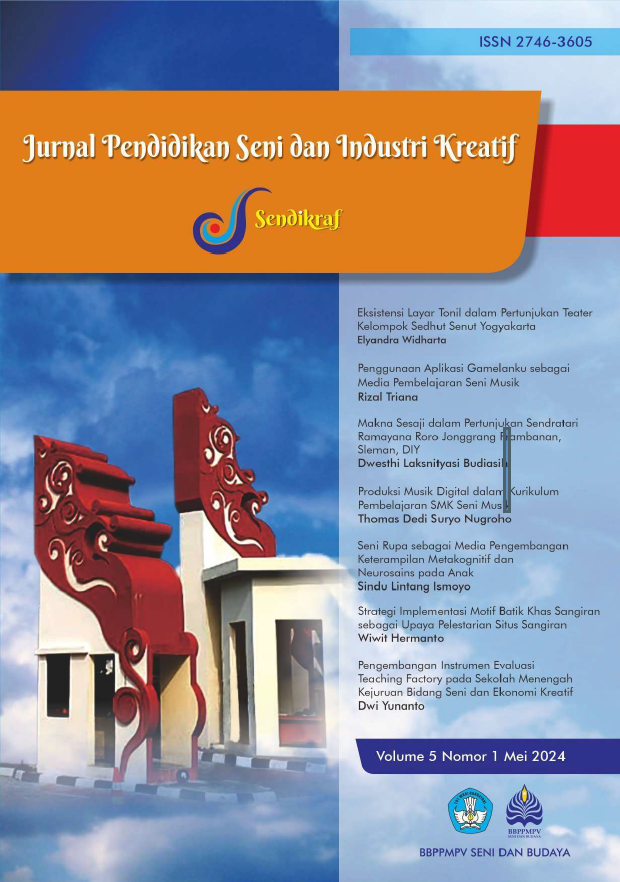EKSISTENSI LAYAR TONIL DALAM PERTUNJUKAN TEATER KELOMPOK SEDHUT SENUT YOGYAKARTA THE EXISTENCE OF TONIL SCREEN IN THE THEATER PERFORMANCE OF SEDHUT SENUT GROUP OF YOGYAKARTA
Main Article Content
Abstract
This paper discusses the existence of the use of tonil screen in theater performances. The Sedhut Senut group, a Javanese-language theatre group in Yogyakarta established in 1998, currently uses a tonil screen in its performances. The idea of the Sedhut Group's tonil screen is interesting to study from the aspect of function which also signifies its existence. In accordance with Koime E. Maloy's notes, the screen tonil of the Sedhut Senut Group shows its function in; 1) Defining the performance space, 2) Creating a floor plan, 3) Creating an environment for the performers and audience, 4) Scene design, 5) Distinguishing realistic and non-realistic theater, 6) Setting the mood and atmosphere of the production, 7) Establishing the style of the production, 8) Establishing the location, 9) Determining the time period, 10) Supporting the overall concept of the production, 11) Presenting the main image or interpretive statement as a whole, 12) Solving practical design problems, and 13) Communicating information about the characters. The distance that still exists between the performers and the audience of tradition-based theater requires a redesign so that communication can be better implemented to build habitus.
Kajian dalam tulisan ini membahas eksistensi penggunaan layar tonil di dalam pertunjukan teater. Kelompok Sedhut Senut, yaitu kelompok sandiwara berbahasa Jawa di Yogyakarta yang berdiri tahun 1998, sampai saat ini menggunakan layar tonil dalam pertunjukannya. Gagasan layar tonil Kelompok Sedhut menarik dikaji dari aspek fungsi yang mana sekaligus menandakan eksistensinya. Sesuai dengan catatan Koime E. Maloy, layar tonil Kelompok Sedhut Senut menunjukkan keberfungsiannya dalam; 1) Mendefinisikan ruang pertunjukan, 2) Membuat denah, 3) Menciptakan lingkungan bagi para pemain dan penonton, 4) Desain adegan, 5) Membedakan teater realistis dan nonrealistis, 6) Mengatur suasana hati dan suasana produksi, 7) Menetapkan gaya produksi, 8) Menetapkan lokasi, 9) Menentukan periode waktu, 10) Mendukung konsep produksi secara keseluruhan, 11) Menyajikan gambar utama atau pernyataan interpretatif secara keseluruhan, 12) Memecahkan masalah desain praktis, dan 13) Mengomunikasikan informasi tentang karakter. Jarak yang masih timbul antara penampil dengan penonton teater berbasis tradisi memerlukan desain ulang agar komunikasi dapat berjalan dengan lebih baik sehingga habitus terbangun.
Article Details

This work is licensed under a Creative Commons Attribution-NonCommercial 4.0 International License.
References
Boen Sri Oemarjati. 1971. Bentuk Lakon dan Sastra Indonesia, Jakarta: Penerbit Gunung Agung.
Bourdieu, P. 1993. The Field of Cultural Production (R. Johnson, Ed.), Columbia University Press.
Harymawan, RM. 1988. Dramaturgi, Bandung PT Rosdakarya.
Jaap Erkelens. 2022. Dardanella : Perintis Teater Indonesia Modern, Jakarta, Penerbit Buku Kompas.
John Russell Taylor. 1966. The Penguin Dictionary of Theatre, Penguin Book Ltd, Great Britain, England.
Kaoime E. Maloy. 2015. The Art oh Theatre Design Element of Visual Composition Method and Practice. Focal Press 70 Blanchard Road, Suite 402, Burlington, MA 01803.
M. Sarief Arief. 2010. Politik Film di Hindia Belanda, Jakarta: Komunitas Bambu.
Mutahir, Arizal. 2011. Intelektual Kolektif Pierre Bourdeiu Sebuah Gerakan Melawan Dominasi, Yogyakarta: Penerbit Kreasi Wacana.
Sumardjo, Jakob. 1992. Perkembangan Teater Modern dan Sastra Drama Indonesia. Bandung: PT Citra Aditya Bakti Nurhadi.
Susanto, Budi.1997. Ketoprak. Yogyakarta: Penerbit Kanisius.
Website :
• https://inibaru.id/tradisinesia/ketoprak- tobong-kesenian-unik-dari-yogyakarta
• https://www.detroitcommediarap.org/single- post/2018/01/23/what-is-commedia-dellarte

